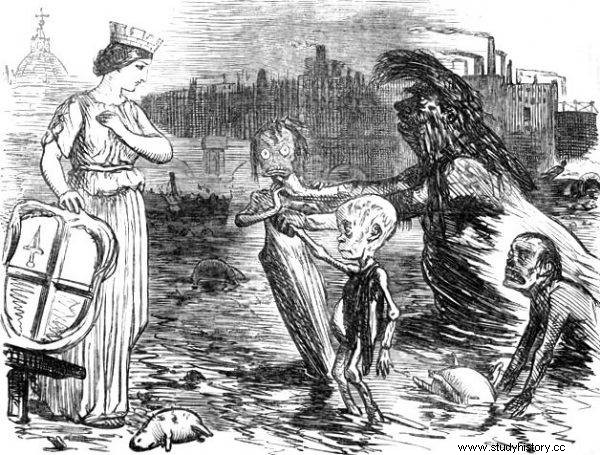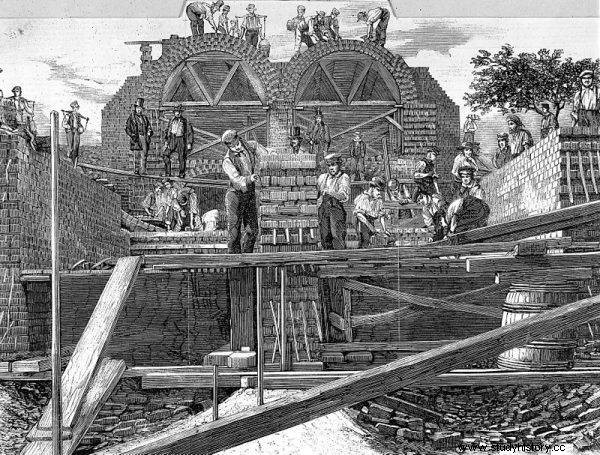We all know how unpleasant odors from sewers can be, especially on a hot summer day. The real problem begins when the main sewage in a city of almost 3 million people breaks down, bringing in a stench so strong that it causes uncontrolled vomiting.
From the very beginning of London's existence, the Thames played an important role in its functioning and development. It was not only a source of drinking water, but also a transport route and the main sewage of the city. As its industrialization progressed, more and more pollutants of all kinds were discharged into the river, both from households and industrial plants such as paper mills, tanneries, breweries and slaughterhouses - not to mention the bodies of suicides, murder victims and even convicts.
Water quality began to raise doubts as early as the 16th century, but despite the awareness of the problem, no improvements were made to eliminate it. It was widely believed that if the river flows, most of the pollution will eventually end up in the sea . And the level of knowledge about the impact of contaminated water on the health of the people of London was negligible, which only made the situation worse, favoring outbreaks of various epidemics.
The first half of the nineteenth century brought an incredible demographic explosion, mainly caused by the industrial revolution. In 50 years, London's population has grown from 1 million to over 2.5 million. These figures were followed by a sharp increase in the amount of wastewater discharged into the river, which instead of flowing downstream began to settle to the bottom, creating an ideal environment for bacteria.
Epidemics of dysentery, typhoid fever and cholera broke out in the city, reaping the bloody harvest. For example, in 1849 the death rate was so high that an average of more than 2,000 Londoners died a week from disease. Unfortunately, most residents, including doctors, blamed the so-called "Plague air", and the solution to the problem was still seen in discharging as much pollution into the river as possible.

Caricature of the personification of the Thames presenting the city of London with its children - diphtheria, tuberculosis and cholera.
Even Dr. John Snow's examination did not open his eyes. In 1854, he proved that drinking contaminated water from a well had an impact on the development of the cholera epidemic in one of the London districts. When the well was closed at his request, the disease practically disappeared overnight. Unfortunately, his discovery was not very popular. It's a pity. Maybe it would help to avoid the disaster that happened 4 years later.
The stench in parliament
The summer of 1858 turned out to be record-breaking hot. It was hot for three months, and daytime temperatures could reach 35 degrees in the shade and even 48 degrees in the sun. The drought contributed to a sharp drop in the water level in the Thames, causing an ecological disaster the city has not yet experienced.
Sources say that in some places the height of the discovered waste heaps was 2 meters. Soon it all began to rot and ferment, producing an unimaginable stench that carried tens of kilometers away. As the wind changed direction, the stench of the river made Londoners violent and vomit they couldn't control. The Thames had become a cesspool that not even Queen Victoria had the courage to swim.

Dirty father Thames, satirical drawing
However, the people responsible for this neglect - parliamentarians - were in the worst position. Their recently rebuilt headquarters, the Palace of Westminster, was located right on the banks of the River Thames. The debating gentlemen had their seats in the first row with a view of the disaster. The phrase "smelly thing" took on a new meaning for them ...
The stench of dirt filled the meeting rooms, corridors and the rest of the rooms, making work difficult. In all the buildings close to the river, the curtains were covered with bleaching chloride, and the Thames itself was neutralized with tons of lime. Unfortunately, these solutions did not bring much results. Relief was provided only by the July rainstorm.
Solving the smelly issue
Although none of the politicians felt responsible for the outbreak of this ecological catastrophe, her empirical experience accelerated the creation of a project aimed at improving the condition of the river and creating a modern sewage network. Its construction was commissioned to engineer Joseph Bazalgette and the total cost of the project is now estimated at £ 340 million.

Works on a new sewage system
Bazalgette was already responsible for the reconstruction of the city's sewage system, which has now been extended to include drainage canals, pumping stations and other accompanying projects that have improved the flow of water in the Thames. During the first 16 years of work, nearly 130 kilometers of canals were built, and the project was finally completed in 1875 .
Bazalgette showed incredible caution in her plans. Instead of doubling the capacity of the canals to double the number of inhabitants at the time, he quadrupled it, solving the problem of sewerage in London for almost a century. As a result, almost immediately after the completion of the first stages of works, the number of cases of infectious diseases dropped, and the capital of Great Britain never suffered again from a similar environmental disaster.
Bibliography
- Bibby, London's Great Stink. Historic UK (accessed February 8, 2021).
- Ashton, One Hot Summer:Dickens, Darwin, Disraeli, and the Great Stink of 1858 . Yale University Press, 2017.
- Gould, Why Fish Fart and Other Useless Or Gross Information About the World . Penguin, 2009.
- Allen, Good Intentions, Unexpected Consequences:Thames Pollution of and The Great Stink of 1858. Victorian Web (access:2/8/2021).
- Lemon, The Great Stink . Cholera and the Thames (accessed 02/08/2021).
